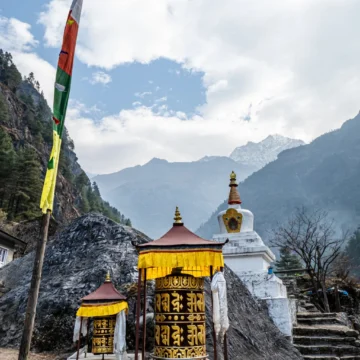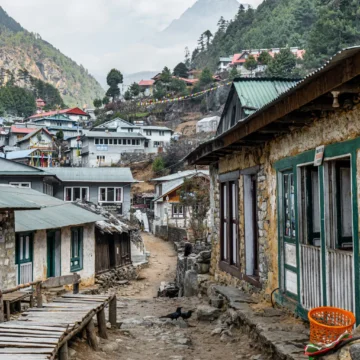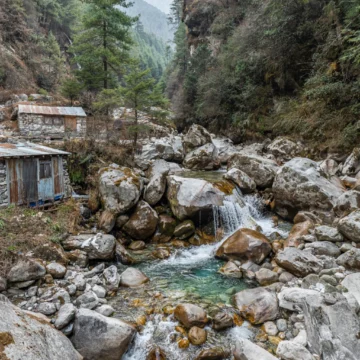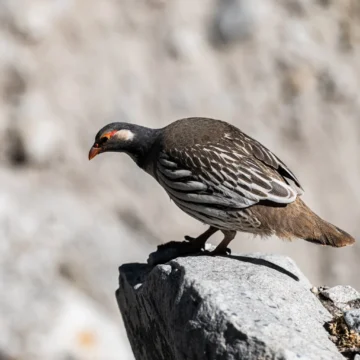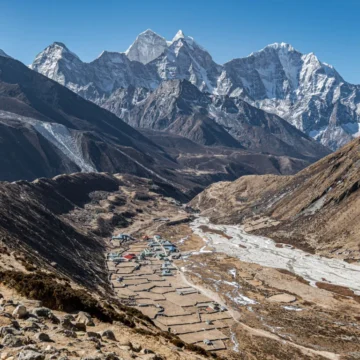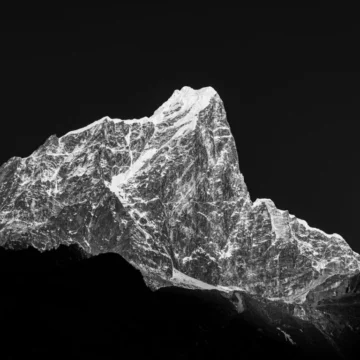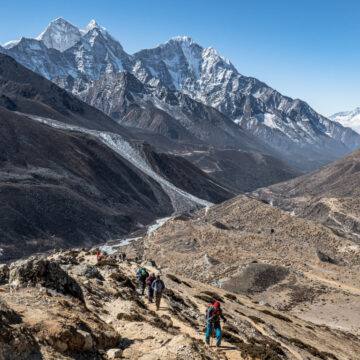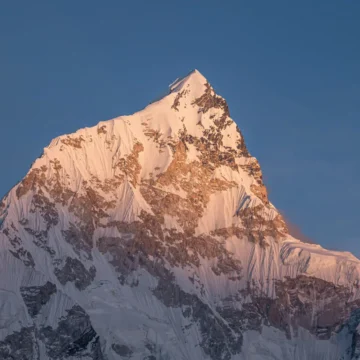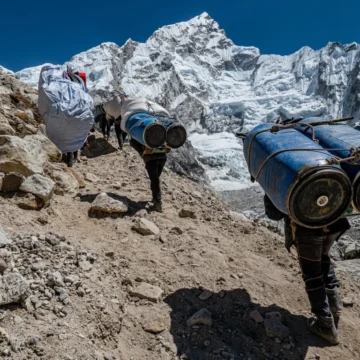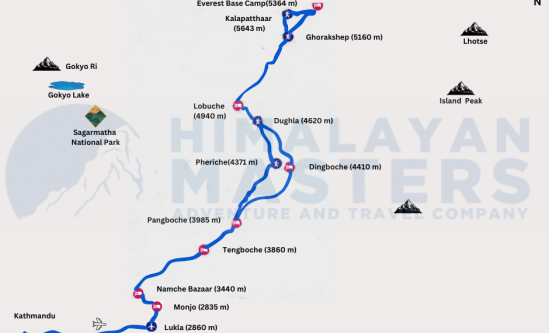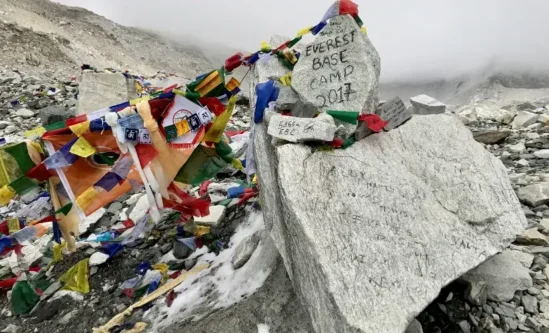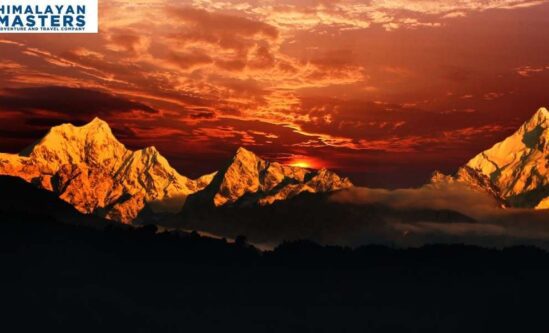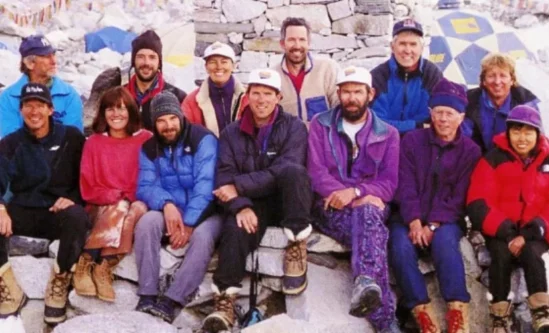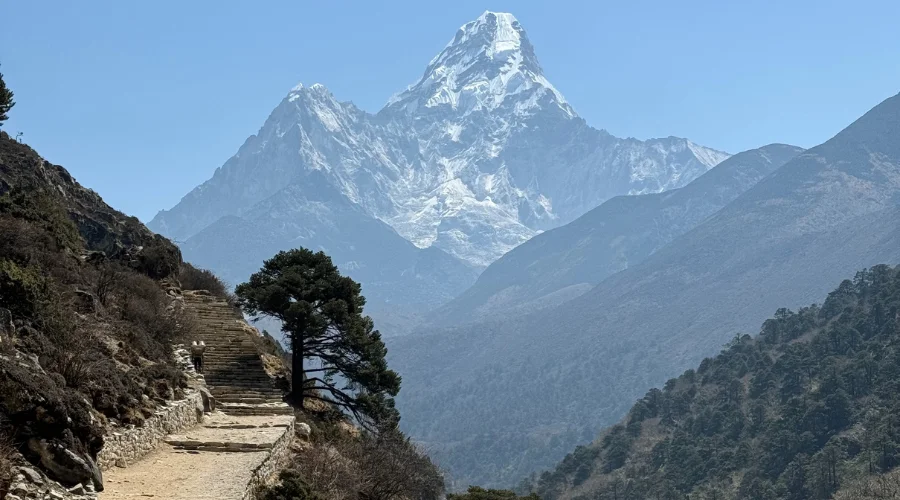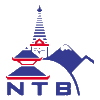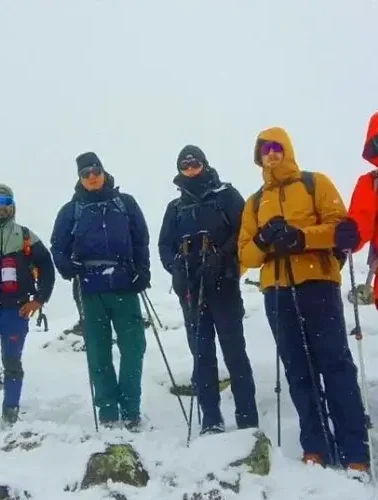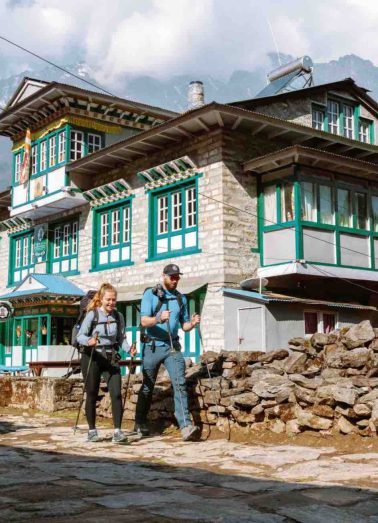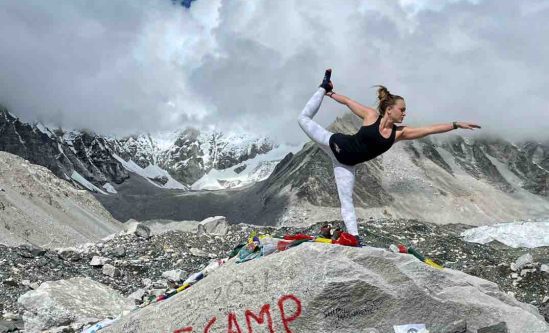
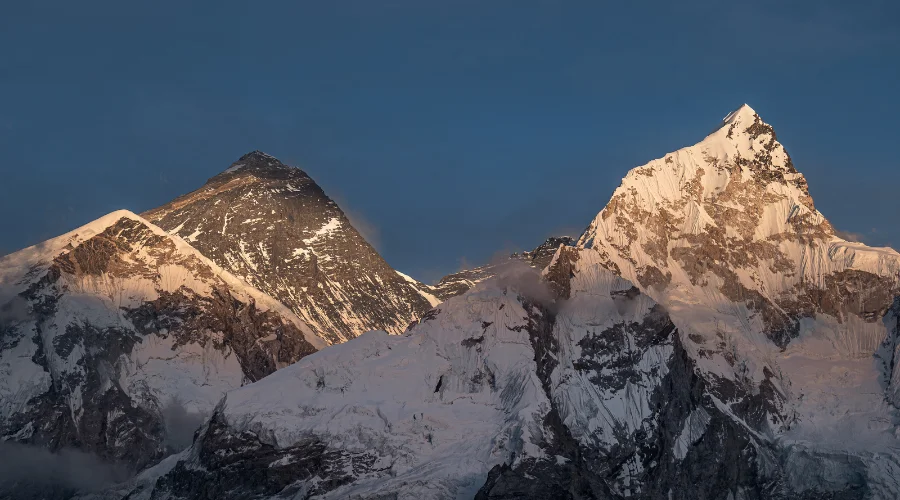
- TRIP DURATION
- 12 Days
- MAX. ALTITUDE
- 5550 m/18209 ft.
- TRIP GRADE
- Moderate
- LODGING
- Tea House
- BEST SEASON
- Spring and Autumn
- MEALS
- Breakfast, Lunch & Dinner
- COMMUNICATION
- Wi-Fi/ Local SIM Card
- PER DAY WALK
- 6 to 7 Hours
Everest Base Camp Trek
Are you ready for the most exciting holiday of your life? Trekking to Everest Base Camp is the world’s most popular adventure. It takes you straight to the Khumbu region of Nepal, home to Mount Everest, the highest peak in the world. The trek to Everest Base Camp blends adventure, remoteness, cultural insight, comfort, and stunning views.
Everest Base Camp Trek Overview
The 12-day Everest Base Camp trek by Himalayan masters is neatly organized with two domestic flights, eight trekking days, and two resting days. The general trekking route will be added at 4000 meters, while the highest point can reach 5,364 meters. You can witness the stunning views of Pumori, Lobuche, Mt. Everest, Manaslu, Lhotse, Nuptse, Cho Oyo, and more from each end.
All treks in the Khumbu region of Nepal begin with a thrilling ride to Lukla. The flight is available mainly from Kathmandu, but you might need to drive to Ramechhap airport during certain seasons. The drive from Kathmandu to Ramechhap is 5-6 hours, and the flight from Ramechhap to Lukla is 25 minutes.
From there, we head north on a complete mountain terrain for the trek to Everest Base Camp. On the first part of the trek, we walk along Dudh Koshi and stop at Phakding. Then, we stroll beyond Sagarmatha National Park to reach Namche Bazaar. This big village in Everest is a great place to stop for a night and witness the beauty of Everest.

From Namche, we will move to Tengboche to visit the critical Tengboche monastery. Moving further north, we stopped at Dingboche for two days. As we acclimatize, we witness great views of Cho Oyu, Ama Dablam, Lhotse, and more Himalayas above 8,000 meters. Then we move to Lobuche and finally to Gorakshep. Gorakshep is our last stop before hiking to Everest Base Camp and Kala Patthar for the most beautiful sunrise in the world during the Mount Everest Base Camp Trek.
Then, we will take a slightly different Everest Base Camp route to Pangboche and reach Namche Bazaar. The next day, we will walk down to Lukla and catch a morning flight to Kathmandu and end the most beautiful journey of our life.
Everest Base Camp Trek Facts
- Two base camps: Nepal (5,364 m) and Tibet (5,150 m)
- Highest Altitude: Kala Patthar 5550 meters/18209 feet
- Distance of the trek: Approx. 130 km/80.77 miles
- Duration of the trek: 12 days
- The beginning point of the trek: Lukla
- The ending point of the trek: Lukla
- Over 40,000 trekkers visit annually
- The world’s highest marathon starts here
- Cultural experience with Sherpas and monasteries
- Khumbu Glacier is constantly moving and melting
- Unpredictable weather, freezing in winter
- There is no direct view of Everest from the base camp
Everest Base Camp Trek Highlights
- An exciting mountain flight to Lukla with the Himalayas before us
- Witness majestic Everest and other mountain peaks right from the Everest base camp height of 5364 meters
- Hiking to Kala Patthar is at 5550 meters above sea level for even more exciting views of Everest
- A rest day in Namche Bazaar to explore its culture and heritage, including Hotel Everest View
- Visit Tengboche Monastery, Namche Monastery and other architectural masterpieces in the region
- Stunning views of the Khumbu Glacier and Icefalls
- Be part of the rich Sherpa culture and festivals while discovering the peace of the mountains.
Everest Base Camp Trek 12 Days Itinerary From Kathmandu
- Day 1: Flight from Kathmandu to Lukla & trek to Phakding
- Day 2: Trek from Phakding to Namche
- Day 3: Acclimatization day at Namche Bazaar (Hike to Hotel Everest View)
- Day 4: Trek from Namche to Tengboche
- Day 5: Trek from Tengboche to Dingboche
- Day 6: Acclimatization day at Dingboche (Hike to Nagarjuna Hill Top)
- Day 7: Trek from Dingboche to Lobuche
- Day 8: Trek from Lobuche to Gorakshep (Hike to Everest Base Camp)
- Day 9: Trek from Gorakshep to Pheriche (Hike to Kala Patthar)
- Day 10: Trek from Pheriche to Namche
- Day 11: Trek from Namche to Lukla
- Day 12: Flight from Lukla to Kathmandu & Overnight at Kathmandu
Everest Base Camp Trek Video
ITINERARY
Day 01: Flight from Kathmandu (1400 m) to Lukla (2840 m) & Trek to Phakding (2610 m)
Route: Kathmandu → Lukla → Chheplung → Thado Koshigaon → Ghat → Phakding
Beginning Point: Lukla
Ending Point: Phakding
Distance: 5-7 km
Total Descent: 222 m
Lunch: Thado Koshigaon
Overnight: Phakding
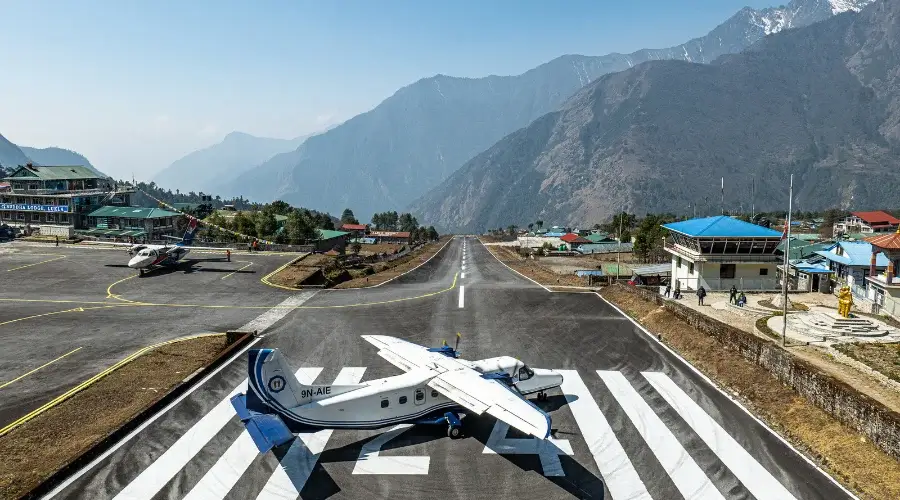
Fly Kathmandu to Lukla
The trip begins at the Kathmandu hotel. From there, the car will pick you up and take you to the airport, where you will catch a 30-35-minute flight to Lukla, the actual place to begin the trek. The unique experience, stunning views of the snow-capped mountains, and beautiful landscapes from the plane give you heavenly pleasure.
Fly Ramechhap to Lukla
Since the flight from Kathmandu to Lukla is limited, it might not always be available. In that case, we must ride from Kathmandu to Ramechhap early, around 4 a.m. After riding for about five hours, you will reach Ramechhap and catch a flight at midday.
Note: During the peak trekking season, the air traffic is high. So, instead of driving gruellingly to Manthali/Ramechhap Airport, you can book a direct helicopter flight to Lukla. The helicopter flight is shared between 5 people and costs $550 per person.
Once you land at Lukla Airport, as popular as Tenzing-Hillary Airport, you must prepare for a nearly 4 hours trek. The trail goes along the Dudh Koshi valley, witnessing the beautiful villages with stony houses, stupas with several meditators, and many carved stones painted beautifully. You will be hiking primarily through the Sagarmatha National Park, a reputed conservation area enlisted in UNESCO Heritage site.
After trekking for about 2 hours, you will stop at Thado Koshigaon for lunch. Again, you will walk for the next one or one and a half kilometres to reach Phakding, where you will stay overnight.
About Lukla
Lukla is a small, bustling village situated at 2840 meters (9318 ft) in the Khumbu region. This area is popular for its thrilling flight runway, one of the world’s shortest (527 m). We will stop here for a short tea break in one of the most comfortable lodges and hire local porters.
The village has about 20-25 decent hotels. You can also visit the local ancient monasteries, Sherpa Museum, police office, and army barracks. Likewise, a local municipality tax of NRS 3000 is collected here for the development of the Everest region.
About Thado Koshigaon
Thado Koshigaon is a small village on the way to Phakding. We will spend a couple of hours here having lunch and rejuvenating ourselves. There are a few teahouses and restaurants with basic facilities.
About Phakding Village
Phakding Village is another small tourist village on the way to the Everest Base Camp (EBC) Trek. There are about 20-25 teahouses with basic to luxurious facilities and 40-50 local houses in Phakding. Himalayan Masters will manage one of the best lodges with an attached bathroom and modern facilities.
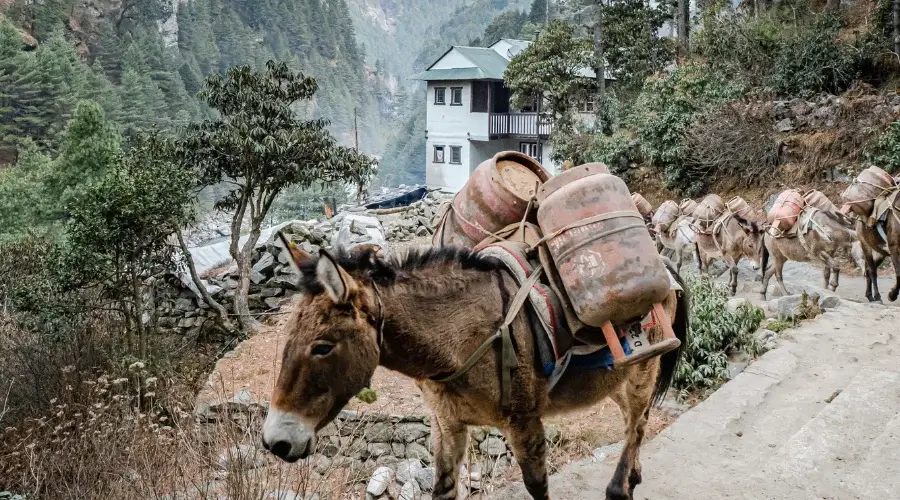
The village is situated at 2610 meters (8563 ft) on the bank of the Dudh Koshi River. If you have time, you can visit the local gompa here.
Meal : Breakfast, Lunch & Dinner
Accommodation : Tea House
Walking / Driving : 30-35 min Flight & 3-4 Hours Walking
Day 02: Trek from Phakding (2610 m) to Namche (3440 m)
Trek Route: Phakding → Monjo → Jorsalle → Hillary Bridge (Larja Dobhan) → Namche Bazaar
Beginning Point: Phakding
Ending Point: Namche Bazaar
Distance: 4 km
Total Ascent: 822 m
Lunch: Jorsalle
Overnight: Namche Bazaar
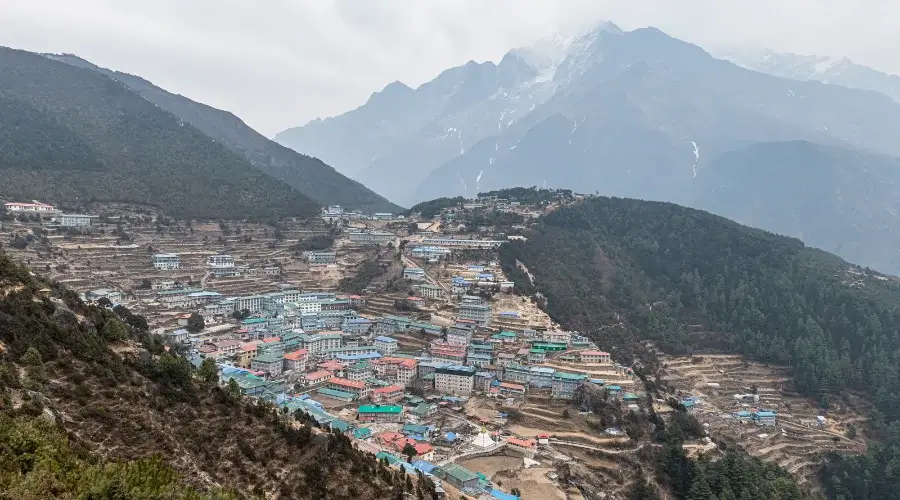
The second day of your Everest Base Camp Trek begins with a delicious breakfast at the teahouse at Phakding. Then, you will walk to Monjo, probably at 7 am. The distance to Monjo is 4.9 km, and from Monjo (2835 m/9301 ft) to Namche Bazaar is 5.5 km.
You must get or submit the Sagarmatha National Park here at Monjo, which costs NRS 3000. It is quite a challenging trek, as there is a long ascent and probably no places to stop. You might need to carry some dry food or chocolate and enough water.
After walking for about half an hour from Monjo, you will stop at Jorsalle for lunch and continue the trek to Namche via Hillary Bridge for the next 2 hours. The route after the Hillary Bridge is a little challenging as you need to walk up a steep hill. However, the first view of Everest on the way is worth the challenge.
About Jorsalle Village
Jorsalle is our lunch station between the Phakding and Namche treks. There are about 5-6 teahouses with basic facilities. The trek continues along the view of the river and lush rhododendron forest during its blooming season (spring and monsoon). Hereafter, there are no teahouses, but you will see many local vendors selling things in “Nanglo”.
About Namche Bazaar
Namche or Namche Bazaar is “The Gateway to Everest.” It is a busy trading market in the Khumbu region. Around 40-50 good-quality lodges provide all kinds of modern facilities. You will be staying in a comfortable lodge, which even has electric heating blankets.
The major attractions of the town are the Saturday market, Sherpa Museum, Sagarmatha National Park Visitor Center, Hillary School, etc. In addition, you can find Rastra Banijya Bank, ATM, Khumbu Money Exchange, pubs, pool houses, art galleries, pharmacies, and many more here in Namche.
Meal : Breakfast, Lunch & Dinner
Accommodation : Tea House
Walking / Driving : 6 to 7 Hours (Walking)
Day 03: Acclimatization Day at Namche Bazaar (3440 m)
Hike Route: Namche Bazaar → Hotel Everest View→ Namche Bazaar
Distance: 7-8 km
Elevation: 3900 m
Total Ascent: 460 m
Lunch: Snacks at Hotel Everest View

The third day of the EBC Trek is a rest day, letting your body adjust to the higher-altitude atmosphere. Some trekkers think the acclimatization day is just a waste of time and ruins almost the whole trip. However, as the next destination, Tengboche, is situated at a significant altitude, it is necessary to acclimatize to avoid any risk of altitude sickness.
Resting or acclimatizing at Namche does not mean spending the whole day sleeping in bed. Today, you can have an extra trek to nearby viewpoints, such as the Sagarmatha National Park Museum, or just stroll around the Namche Bazaar and go shopping.
One of the most popular viewpoints is the Hotel Everest View, which is about two hours’ climb uphill and an hour’s climb downhill.
The viewpoint situated at an elevation of 3900 meters (12,795 ft) offers an excellent up-close view of Everest and other mountains such as Nuptse, Ama Dablam (6856 m), Lhotse, Shar, Taboche, etc. You can also visit one of the most popular Sherpa Villages: Khumjung and Kunde.
Meal : Breakfast, Lunch & Dinner
Accommodation : Tea House
Walking / Driving : Around 3 Hours Walking (If the Trekkers want to)
Day 04: Trek from Namche (3440 m) to Tengboche (3860 m)
Trek Route: Namche Bazaar → Khyangjuma → Phunke Tenga → Tengboche
Beginning Point: Namche Bazaar
Ending Point: Tengboche
Distance: 6 km
Total Ascent: 420 m
Lunch: Phunke Tenga
Overnight: Tengboche
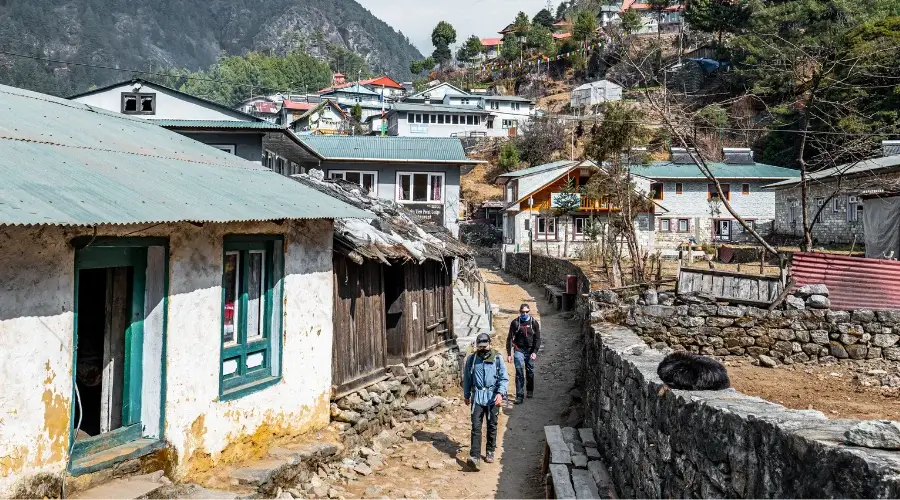
You will start your trek early, at around 8 to 9 a.m. The path to Tengboche is rocky and filled with sand as we move along the Dudh Koshi River. But a quick stop at Phunke Tenga in the middle of the forest is exciting, where we will have.
After departing from Namche to the wilderness of Everest, you will follow a curvy and sloppy uphill to the Khyangjuma (3550 m) until Phunke Tenga. From here, the route follows a steep uphill to Tengboche and stays overnight, covering around 4 km.
About Phunke Tenga Tea House
Phunke Tenga is a small village at 3250 meters (10,663 ft) along the Dudh Koshi River. You will spend a couple of hours here for lunch in one of the teahouses. There are only 5-6 teahouses here, offering great river views originating from Everest and Gokyo Lakes.
About Tengboche Village
Tengboche village is a small picturesque village on the way to the EBC Trek. It is situated at 3860 meters (12,664 ft) and has around 3-4 mid-range teahouses. However, the local food served in these teahouses is excellent. The major highlight of the village is the Tengboche Monastery.
Prayer flags and mantra wheels along the way will lead us to Tengboche Monastery. Tengboche Monastery is one of the oldest monasteries in Nepal, built-in 1916 by Lama Gulu. In the evening, we will visit the stupa for evening prayer and end our EBC Everest trek on the fourth day on a beautiful note.
Meal : Breakfast, Lunch & Dinner
Accommodation : Tea House
Walking / Driving : 5 to 6 Hours (Walking)
Day 05: Trek from Tengboche (3860) to Dingboche (4410 m)
Trek Route: Tengboche → Deboche → Pangboche → Somare → Dingboche
Beginning Point: Tengboche
Ending Point: Dingboche
Distance: 8 km
Total Ascent: 550 m
Lunch: Somare
Overnight: Dingboche
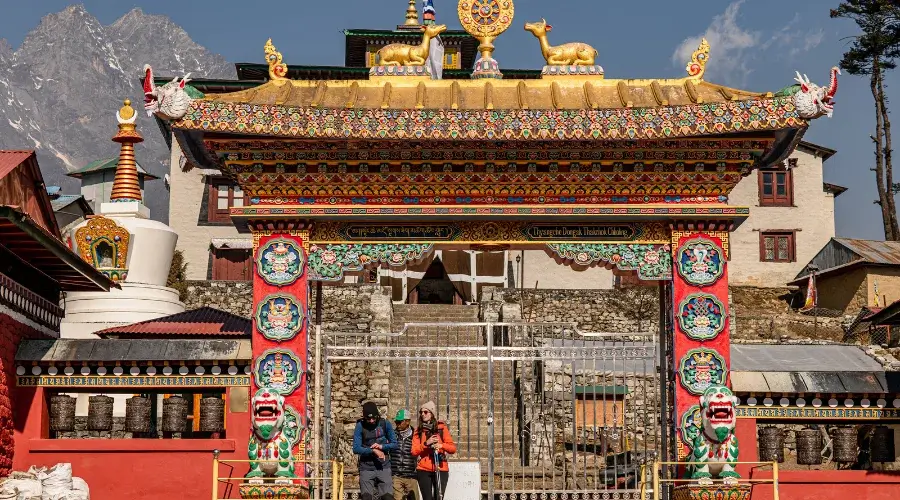
It’s one of the challenging days with steep hills to cross. You will have breakfast in Tengboche and trek along the scenic view of Imja Khola. Further, after crossing Deboche (3820 m), you can see the Imja River and Dudh Koshi River junction from the suspension bridge before reaching Pangboche (3930 m).
After walking for about 1.5 km and an additional 2.5 km, you can reach Somare, where you will have today’s lunch. After lunch, you will have a 3-hour trek to Dingboche, covering about 4-5 km, our final destination for the day.
About Pangboche
Pangboche is a small village in the Everest region situated at 3930 meters (12893.7 ft). It is famous for one of the oldest monasteries in the Khumbu region, Pangboche Monastery, which is over 350 years old and was built by Lama Sangwa Dorjee. Likewise, you can see a statue depicting the head of Yeti. Furthermore, Pangboche is known for one of the best views of Ama Dablam.
About Somare
Somare is our lunch breakpoint, situated at 4010 meters (13,156 ft). There are about 4-5 basic teahouses here. From here, you can enjoy the panoramic Himalayan view. Additionally, the path offers a calming river view and jungle view that leads us to Dingboche.
About Dingboche
Dingboche is situated at an altitude of 4410 meters (14,468.5 ft). Dingboche has about 20-25 teahouses, ranging from basic to quality. You can spend some time here playing pool if you feel like it or visit the bakery and savour bakery items.
Meal : Breakfast, Lunch & Dinner
Accommodation : Tea House
Walking / Driving : 6 to 7 Hours (Walking)
Day 06: Acclimatization Day at Dingboche (4410 m)
Hike Route: Dingboche → Nagarjuna Hill Top → Dingboche
Distance: About 5 km
Elevation: Nearly 5000 m
Total Ascent: Nearly 600 m
Lunch: Packed lunch
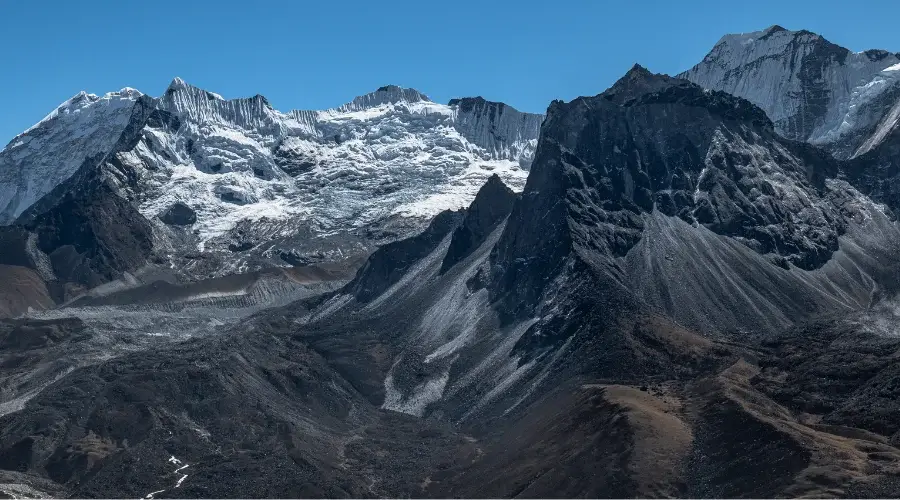
It’s a rest day in the Himalayas. You can sleep all morning or hike up to the nearby hill at the base of Nangkar Tshang Peak called Nagarjuna Hill Top Viewpoint. The hike to the viewpoint takes around 3 hours to climb uphill and 2 hours to climb downhill. You can see one of the best views of Makalu, Lhotse, Lhotse Shar, and Island Peak from the viewpoint. Remember to carry a packed lunch for the way.
You can explore the areas around Dingboche with the guide or simply rest all day.
Now, you are almost 14 km from the EBC, and the journey keeps getting interesting.
Meal : Breakfast, Lunch & Dinner
Accommodation : Tea House
Walking / Driving : Around 5 Hours Walking (If the Trekkers want to)
Day 07: Trek from Dingboche (4410 m) to Lobuche (4940 m)
Trek Route: Dingboche → Dusa Kharka → Thukla/Dughla → Thokla Pass → Lobuche
Beginning Point: Dingboche
Ending Point: Lobuche
Distance: 6-7 km
Total Ascent: 500 m
Lunch: Thukla
Overnight: Lobuche
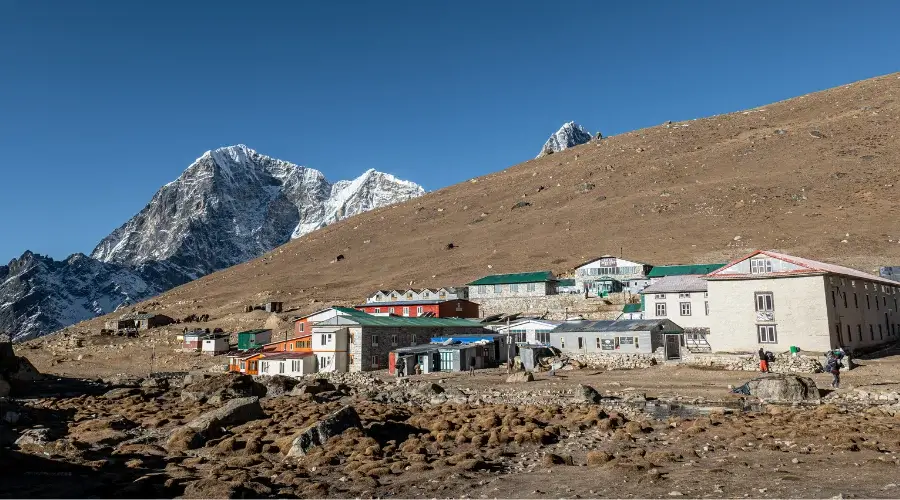
The trek to Lobuche begins after having a delicious breakfast at the teahouse at around 7:30. Many trekkers consider this day the most beautiful day of the trip.
The beautiful scenery from Dingboche to Dughla via Dusa Kharka (4530 m), filled with snow peaks, glaciers, rivers, and a wonderful forest with a few rhododendron trees, is fantastic.
After a refreshing lunch at Thukla, the gentle slope ends, and a steep landscape begins. Keep yourself hydrated and walk with relaxation to prevent AMS.
Once you pass the top of Thokla Pass (4830 m), you will walk along the river and witness the tremendous views. Lastly, enjoy your dinner at Lobuche and go to sleep.
About Thukla (4620 m/15,157.48 ft)
Thukla, a beautiful village called Dughla, is the only station to stop along the trail. There are about 2-3 teahouses here. You’d better stop and rest there as the significant ascent begins right after Thukla. You will find no stops until you reach the day’s destination, Lobuche.

About Lobuche
Lobuche is a beautiful village in the Everest region situated at an altitude of 4910 meters (16109 ft). There are 5-6 basic teahouses in Lobuche that provide decent food and accommodation.
Lobuche is popular for its awesome views of Lobuche Peak: Lobuche East (6119 m) and Lobuche West (6145 m), Nuptse (7861 m), and Kangchung Peak (6063 m).
Meal : Breakfast, Lunch & Dinner
Accommodation : Tea House
Walking / Driving : 6 to 7 Hours (Walking)
Day 08: Trek from Lobuche (4940 m) to Gorakshep (5164 m) & Hike to Everest Base Camp (5364 m)
Trek Route: Lobuche → Gorakshep → Everest Base Camp → Gorakshep
Beginning Point: Lobuche
Ending Point: Everest Base Camp (EBC)
Distance: About 12 km
Maximum Elevation: 5364 meters (17,598 ft) at EBC
Total Ascent: 454 m
Descent: 224 m
Lunch: Gorakshep
Overnight: Gorakshep
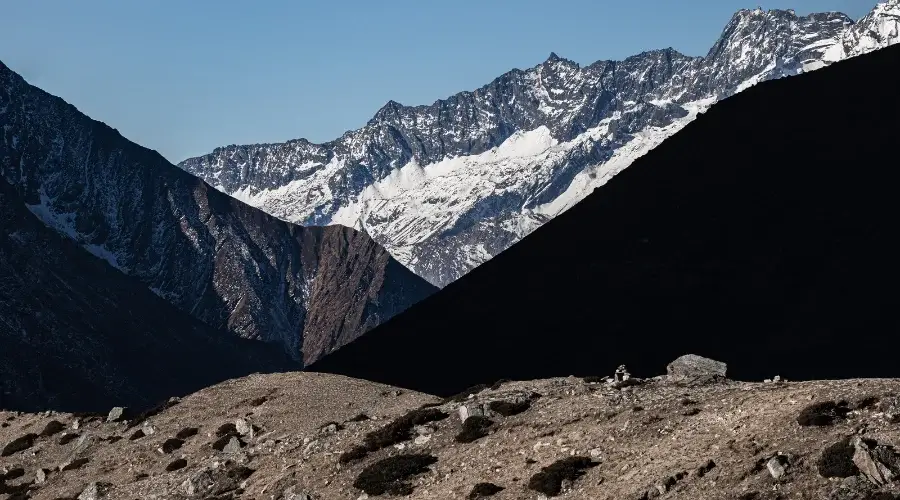
Day 8 of the trip is one of the best days as you will be stepping on the final destination of the journey, Everest Base Camp. The distance from Lobuche to Gorakshep is about 5 kilometres. You will have your lunch at Gorakshep.
After having lunch and relaxing for a while, you need to be prepared for another 7-hour hike up and down to EBC.
The trail from Gorakshep to EBC has lots of short ascents and descents. Keep walking up and down with the titillation of reaching Everest Base Camp, the dream destination of millions of people worldwide. Hurray! You’ve done it! You’ve been to EBC. You can either spend the night at EBC or descend back to Gorakshep.
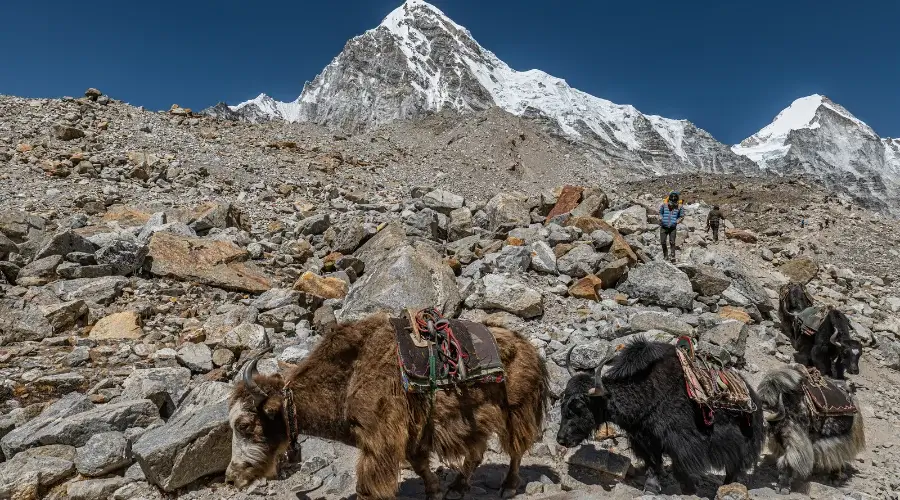
You can take photos and videos, relax, and make lifetime memories here. You can also see one of the best views of the mountains of the Mahalangur Himalayan range, including Everest, Pumori, and Nuptse.
Well, after Everest base camp, this option is also possible if you want to go back to Kathmandu by helicopter. You can take a helicopter from Gorakshep.
About Gorakshep
Gorakshep is a popular village in the Everest region, situated at 5140 meters (16,863.5 ft). There are about 5-6 good quality lodges at Gorakshep. The route to Gorakshep is a rocky, sloping hill with glaciers.
Meal : Breakfast, Lunch & Dinner
Accommodation : Tea House
Walking / Driving : 9 to 10 Hours (Walking)
Day 09: Hike from Gorakshep (5164 m) to Kala Patthar (5550 m) & trek to Pheriche (4240 m)
Trek Route: Gorakshep → Kala Patthar → Gorakshep → Lobuche → Thukla → Pheriche
Beginning Point: Gorakshep
Ending Point: Kala Patthar
Distance: About 18 km
Total Descent: 924 m
Lunch: Thukla
Overnight: Pheriche
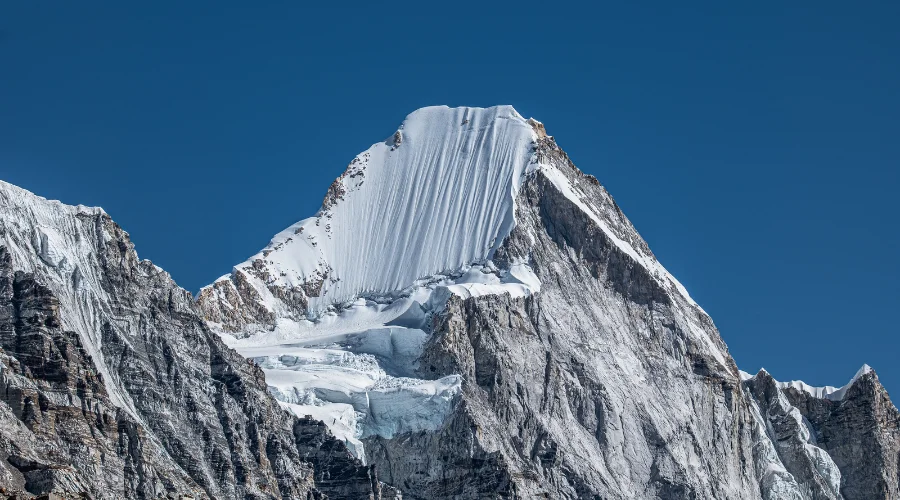
This day is the most challenging as you must walk a long distance, nearly 14-15 kilometres. Today, you must hike up to Kala Patthar, descend back to Gorakshep, and finally, to Pheriche via Lobuche.
Gorakshep to Kala Patthar
Kala Patthar (Black Rock) is the most critical viewpoint (called Everest View Range Viewpoint) on the trip. It is the highest point of the EBC trek, reaching 5550 meters (18,209 ft). It takes around 3 hours to reach Kala Patthar and about 1.5 hours to return to Gorakshep.
Kala Patthar offers 360-degree mountain views. The major highlight is the up-close view of Everest. Remember to take photos and videos and enjoy the moment.
If you can reach early in the morning, you can see a unique sunrise view. Also, if you want to go to Gokyo Lake Trek, you can go after Kala Patthar from Lobuche.
Gorakshep to Pheriche
After spending a few moments in Kala Patthar, we need to trek back to Gorakshep and to Pheriche, the final destination for the day. With an approximately 4–5-hour trek via Lobuche and Thukla, we will reach Pheriche at around 4 p.m., covering around 11 km. There are about ten basic teahouses in Pheriche. Thukla is going to be our lunch spot for the day.
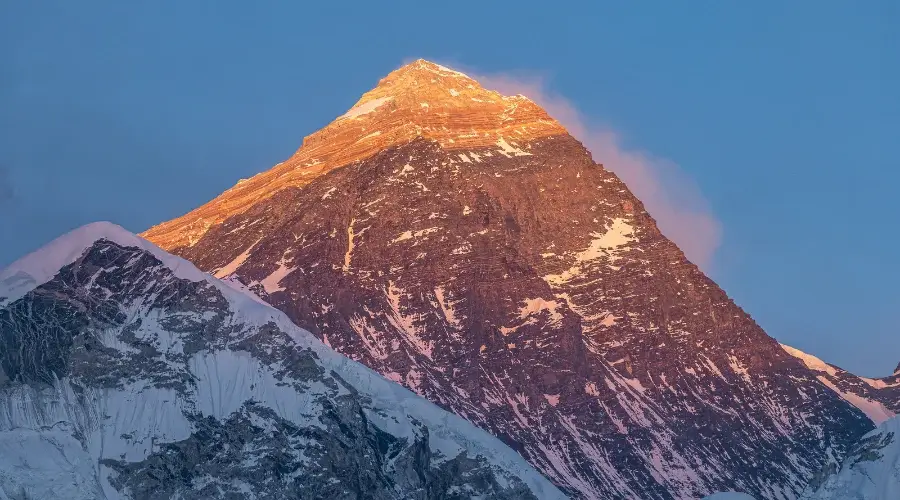
From Pheriche, you can visit Himalayan Rescue Association Nepal (Everest Base Camp Clinic) if you have enough time and stamina to get there.
Meal : Breakfast, Lunch & Dinner
Accommodation : Tea House
Walking / Driving : 8 to 9 Hours (Walking)
Day 10: Trek from Pheriche (4240 m) to Namche (3440 m)
Trek Route: Pheriche → Somare → Pangboche → Tengboche → Namche Bazaar
Beginning Point: Pheriche
Ending Point: Namche Bazaar
Distance: 15-18 km
Total Descent: 800 m
Lunch: Tengboche
Overnight: Namche Bazaar
Today is going to be a long walking day. You need to walk for around 6-7 hours, covering nearly 19 km. The trekking route goes through Somare, Pangboche, and Tengboche to Namche Bazaar. Again, you will spend a comfy night in one of the best lodges in Namche.
During the EBC Everest trek, there are two routes from Pangboche to Namche Bazar.
The first route is via Tengboche, which is the same path you took while going.
The second is through Phortse (3810 m), which is a little more challenging but offers scenic views.
Despite the difficulty, we recommend our clients take the route through Phortse, as the trail will have panoramic mountain views.
Usually, our guides will stop at Pangboche or Tengboche for Lunch. However, you can stop anywhere and enjoy lunch along the majestic view of the mountain and its surroundings.
Meal : Breakfast, Lunch & Dinner
Accommodation : Tea House
Walking / Driving : 6 to 7 Hours (Walking)
Day 11: Trek from Namche (3440 m) to Lukla (2840 m)
Trek Route: Namche Bazaar → Monjo → Phakding → Ghat → Lukla
Beginning Point: Namche Bazaar
Ending Point: Lukla
Distance: 16-18 km
Total Descent: 222 m
Lunch: Phakding
Overnight: Lukla
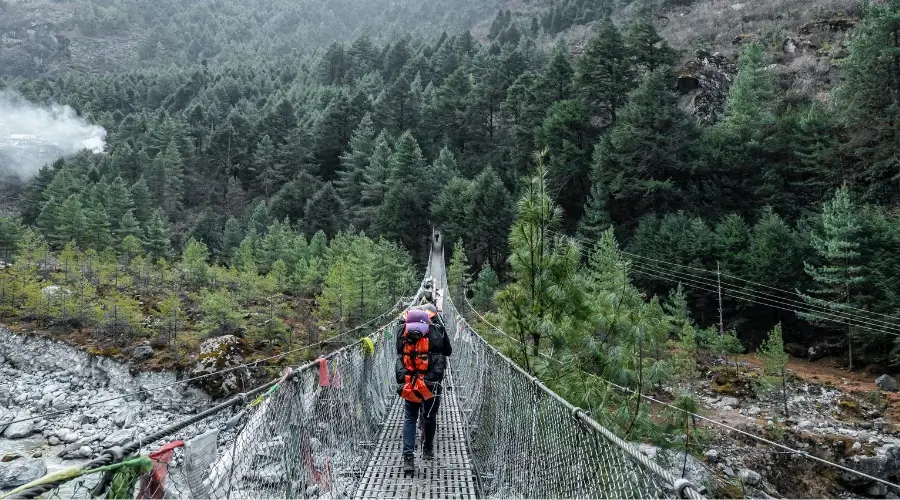
It is the last day of our trek. The trek from Namche to Lukla is challenging, as you need to walk for nearly 6-7 hours, covering approximately 18-20 km. The trail passes along the Dudh Koshi River. As you cross the suspension bridges and pass through the small villages with tiresome bodies, you will see many bright-eyed trekkers heading in the opposite direction.
It is just the same route you walked on the 2nd day. Jorsalle, Monjo, Phakding, etc., are the major stations where you can stop and rest and enjoy the beautiful mountain views. Ghat, Thado Koshigaon, and Chheplung are other important stops between Phakding and Lukla. Upon arriving at Lukla, you will stay overnight at one of the best hotels.
Enjoy the last night in the mountains, celebrating the successful trek. You will probably get the farewell party with ‘Chhyang’, the homemade beer made of rice, and learn a few steps of Sherpa dance.
Meal : Breakfast, Lunch & Dinner
Accommodation : Tea House
Walking / Driving : 7 to 8 Hours (Walking)
Day 12: Flight from Lukla (2840 m) to Kathmandu (1400 m)
Flight Route: Lukla → Kathmandu
Beginning Point: Lukla
Ending Point: Kathmandu
Distance: 136 km
Total Descent: 1440 m
Overnight: Kathmandu
It’s a day to say goodbye to the mountains and return to Kathmandu. After breakfast at the hotel, you will go to the Tenzing-Hillary Airport and take a nearly 30 to 35 minutes flight to Kathmandu. Try getting a seat at the window so you can cherish the beautiful mountain views and the views of panoramic landscapes. The flight is really impressive over the uneven terrain of Nepal. It is the end of EBC trekking.
Once you reach Kathmandu, our team will drop you off at your hotel. Later, once you have freshened up and relaxed, we can meet over coffee and share your trekking experience with Himalayan Masters.
Meal : Breakfast, Lunch & Dinner
Accommodation : Hotel
Walking / Driving : 30 to 35 Min (Flight)
Fixed Departure
| Trip Date | Trip Status | |
|---|---|---|
| 28-10-2024 | OPEN | book now |
| 26-02-2025 | GUARANTEED | book now |
| 01-03-2025 | GUARANTEED | book now |
| 01-03-2025 | GUARANTEED | book now |
| 05-03-2025 | GUARANTEED | book now |
| 10-03-2025 | GUARANTEED | book now |
| 14-03-2025 | GUARANTEED | book now |
| 18-03-2025 | LIMITED | book now |
| 19-03-2025 | GUARANTEED | book now |
| 24-03-2025 | GUARANTEED | book now |
| 30-03-2025 | GUARANTEED | book now |
| 04-04-2025 | GUARANTEED | book now |
| 09-04-2025 | GUARANTEED | book now |
| 14-04-2025 | GUARANTEED | book now |
| 19-04-2025 | GUARANTEED | book now |
| 20-04-2025 | GUARANTEED | book now |
| 24-04-2025 | GUARANTEED | book now |
| 01-05-2025 | GUARANTEED | book now |
| 04-05-2025 | GUARANTEED | book now |
| 10-05-2025 | GUARANTEED | book now |
| 15-05-2025 | GUARANTEED | book now |
| 21-05-2025 | GUARANTEED | book now |
| 27-05-2025 | GUARANTEED | book now |
| 12-08-2025 | GUARANTEED | book now |
| 01-09-2025 | FULL | book now |
| 09-09-2025 | GUARANTEED | book now |
| 16-09-2025 | LIMITED | book now |
| 23-09-2025 | GUARANTEED | book now |
| 24-09-2025 | GUARANTEED | book now |
| 25-09-2025 | FULL | book now |
| 01-10-2025 | OPEN | book now |
| 11-10-2025 | OPEN | book now |
| 15-10-2025 | OPEN | book now |
include / exclude
Trip Cost Includes
- International and Domestic Airport pickup and drop-off by private vehicle
- Three nights at a Three-star hotel in Kathamndu (2 nights before the trek and one night after the trek)
- Kathmandu or Ramchechap to Lukla to Kathmandu airfare
- A Professional English-speaking Trekking Guide for Trekking Days
- A trekking porter for trekking days (one porter carries a maximum of 25 kg)
- 1 set breakfast, 1 set lunch, and 1 set dinner with tea and coffee during trekking days
- 3 cups of hot drinks a day
- The best available private room accommodation during the trek. We provide private bathrooms with hot showers in Phakding, Namche, and Lukla.
- In the Namche, three nights of accommodation with electricity blankets
- Sagarmatha National Park fees
- Khumbu municipality area permits
- Guide and Porter Insurance
- Khumbu municipality permits
- All government taxes and company service charges
- Himalayan Masters Brand 25-degree sleeping bag during the trip
- Himalayan Masters Brand -25 Down jacket during the trek
- Use a pulse oximeter to monitor your oxygen saturation and heart rate at high altitudes.
- Himalayan Masters brand water bottles and purification tablets
- First aid kit box
- Seasonal fruits for dessert
- Himalayan Masters Brand Duffle Bag for the Trek
- Himalayan Masters Brand Trekking T-Shirt and Cap
- Everest trekking maps
Trip Cost Excludes
- International Flight Ticket
- Nepal visa fee
- Tips for guide and potters
- Extra nights in Kathmandu
- Travel Insurance
useful info
Everest Base Camp Elevation
Everest Base Camp is at 5,364 metres, and another location in the EBC trek has the following Everest altitude scale:
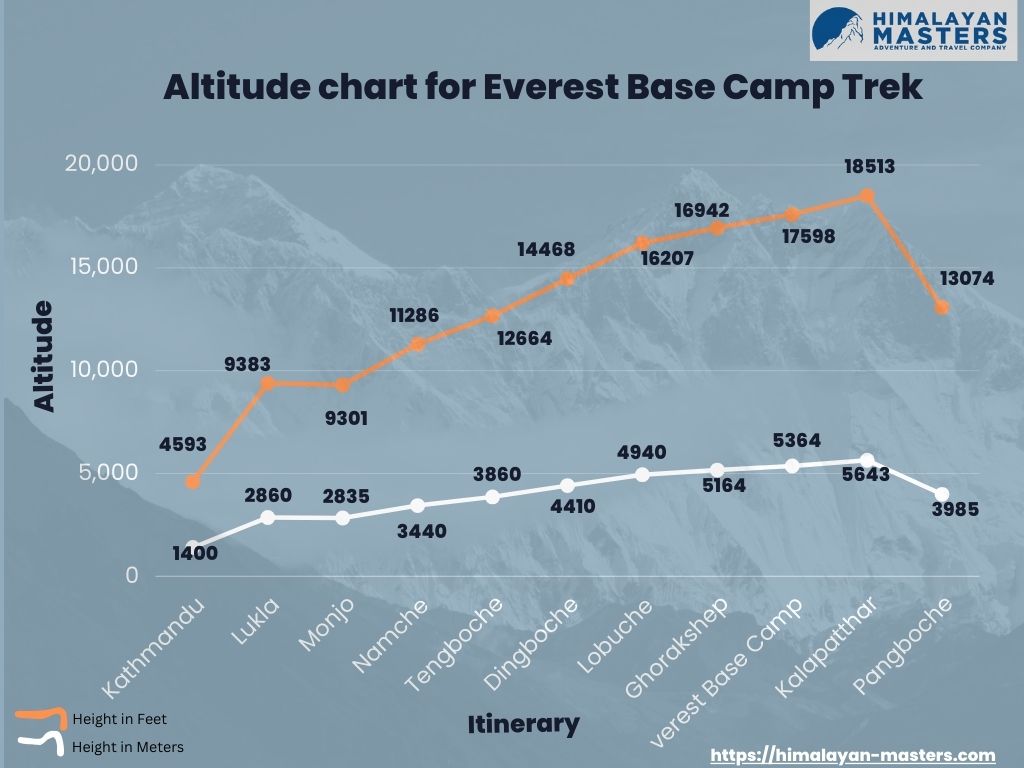
New Updates on a flight from Ramechhap to Lukla
Previously, all flights from Lukla would be operated from Kathmandu, and you could start trekking to Everest Base Camp from there. However, flights to Lukla would be used from Ramechhap after the recent development. This change has been made to Kathmandu airport’s recent air traffic expansion.
Flights to Lukla from Kathmandu will be operated during nonpeak seasons of the Mount Everest Base Camp trek: winter (December, January, February) and Monsoon (June, July, August).
Flights from Ramechhap/Manthali to Lukla will be operated during the peak seasons of autumn (September, October, and November) and spring (March, April, and May). Ramechhap is a 5—to 6-hour drive from Kathmandu, and this change adds one day to your Itinerary. Alternatively, you can wake up about 4 a.m. early and get a private ride to Ramechhap.
Lukla Flight Information: All You Need to Know!
We want to inform you about the Lukla flight details, which may affect your itinerary. Due to air traffic expansion, during peak seasons (including March, April, May, October, and November), the flight to Lukla will be operated from Ramechhap/Manthali, about a 5 to 6 hours drive from Kathmandu.
The flight is conducted from Kathmandu during nonpeak seasons (including January, February, June, July, August, September, and December). The airline’s decision to operate flights solely depends on the volume of travellers during the specific month.
Unpleasant weather conditions, congested airport traffic, an unmanaged runway, topographical difficulties, and other factors are significant reasons for Lukla flight delays or cancellations.
Therefore, if you intend to trek in the Everest region, adding one or two days to your trip is highly preferable. This will help in case of a flight delay or cancellation so you can board the pre-planned international flight.
Chances of Flight Delay and Cancellation
Unstable weather like rainfall, snowfall, and storms in summer and winter are the common causes of flight cancellations or delays during the mt Everest Base Camp trek. Your flight can delay a few hours to a few days if the weather in Lukla does not clear up.
Such a delay will not cost you additional money, but you might have to stay in Kathmandu longer. Note that this is a rear case, and if you encounter bad weather, we can change your trekking route or make another arrangement.
Everest Base Camp Trek Difficulty
The Everest Base Camp trek difficulty is classified as moderate to challenging. It assesses general fitness, determination, and readiness to face and overcome high-altitude trekking. The trek often lasts about 12-14 days to help hikers adapt to the region’s altitude.
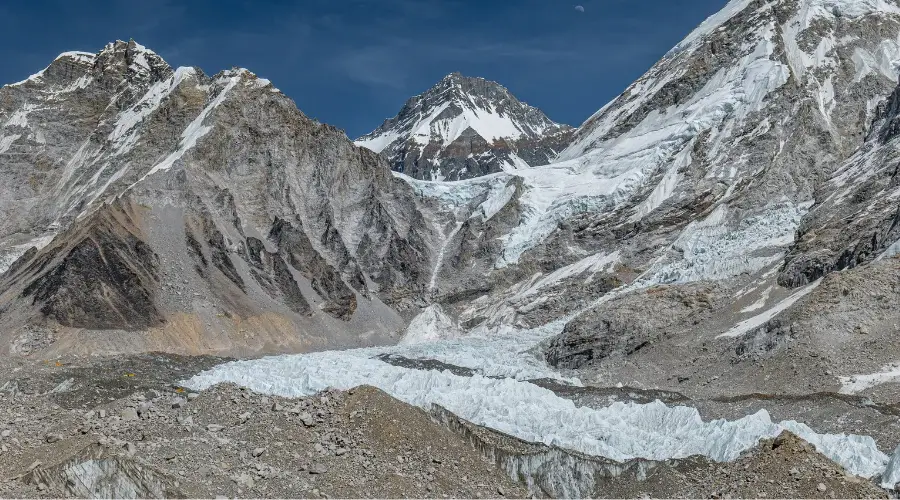
Physical challenges include rugged trails, steep climbs and descents, snow surfaces, and crossing hanging bridges. Trekkers should expect to walk for several hours each day, at times, through poor and harsh weather.
Fitness Level, Medical, and Health
The Everest Base Camp trek needs at least some form of physical exercise and fitness for the tourist to undertake the journey. They should be able to walk for 4-6 hours per day.
Leg strength also helps with balance and stability movements during the trek. Other features that can be considered are overall fitness, stamina, weight, and mental health.
Before undertaking the trek, you should seek medical advice from a qualified doctor concerning your fitness or any disease you suffer from.
Altitude Sickness in Everest Trek
Due to the high altitudes, the climate remains a concern, with some areas registered above 5,000 meters. Low oxygen concentration levels raise the risk of altitude sickness at EBC.
Certain dos and don’ts when it comes to trekking, including acclimatization, adequate water intake, and knowing the indications of altitude sickness.
Trekking Experience
Trekking experience is not a must but goes a long way in overcoming the rigours of the Everest Base Camp Trek. Pre-trekkers should know how to trek, walk, use poles, and handle rough terrain. In addition, it is advised to practice the trek through cardiovascular activities and strength training exercises.
Emergency and Evacuation in EBC Trek
Everest helicopter service providers are throughout the trekking trail in case of an emergency or medical complications. However, these services are paid and can not always be accessed for bad weather or other reasons. All trekkers must have full travel insurance that includes ‘altitude limit’ and ‘medical evacuation.’
Packing list for Trek to Everest Base Camp
For the flight from Kathmandu to Lukla, a 15-kg bag per person is allowed. You can pay extra for more baggage, but we do not recommend carrying more than this for the Everest Base Camp trek packing list.
A porter to Everest Base Camp will carry the bags of two trekkers, and it’s ideal to keep your duffle bag at 10 to 15 kg. The handbag or day carry bag can weigh between 2 and 3 kg.
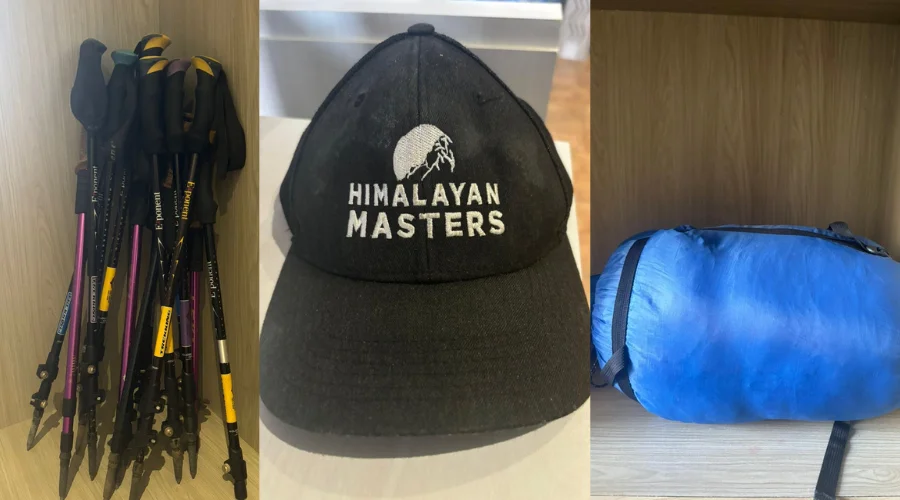
Must haves for the Everest Base Camp trek are:
Clothing
- Hiking shirts (2-3)
- Long-sleeved shirt
- Fleece jacket
- Lightweight cotton pants (2)
- T-Shirts (3-4, bring lightweight wool)
- Polypropylene underwear (5-7 pairs)
- Down jacket (available for rent in Kathmandu)
- Sweater
- Waterproof jacket and pants
- Hiking boots
- Thick wool socks (5-7 pairs, take an extra pair of thick light socks)
Head
- Sun hat or scarf
- Winter hat insulating hat, or wide-brimmed hat
- Headlight with extra batteries
Face
- Sunscreen
- Sunglasses with UV protection
- Face/body wipes
Hands
- Lightweight gloves
- Heavyweight winter gloves
Footwear
- Hiking boots sturdy
- Thick wool socks (5-7 pairs, take an extra pair of thick light socks)
- Crampons if necessary
Essential Gear
- Backpack or daypack (Size depends on whether you take a porter or not)
- Thermal bottle
- Water purification tablets
- Trekking poles
- Sleeping bag (-15°C bag is best in high altitude trekking, available for rent in Kathmandu)
Toiletries
- Medium-size drying towel
- Toothbrush
- Toothpaste
- Deodorant
- Floss
- Biodegradable bar soap
Personal Accessories
- Money
- Watch
- Cell phone
- Camera
Extra Items
- First aid kit
- Extra passport photos and photocopies of passport
- Notebook and pen
- Binoculars
Complimentary By Himalayan Masters
- Duffel bag (100L minimum)
- Trekking cap
- T-shirt
- Water Purification Tablets
- Sleeping bags, Trekking Poles and Down jackets should be returned.
Notes:
Keep your valuables in the daycare bag, such as jewellery, cash, and gadgets. Some drinks, a snack bar, and water bottles should also be in the day bag.
If you want the original brand, you can buy these trekking items in your home country. If you will make them cheaper, you can buy them in Thamel before the Mt. Everest Base Camp trek. Do note that you can rent all this trekking gear from Kathmandu for less than $100.
Best Time to Visit Everest Base Camp Trek
The most popular trekking months in the Everest region are March, April, May, October, and November. These months are the best time for the Everest trek due to the best conditions. Moreover, spring and autumn usually have comfortable temperatures, fine weather, less rain, and less chance of problematic snowfall in the region. Also, if you travel here during this time of the year, you can even explore the biggest festivals in the country.
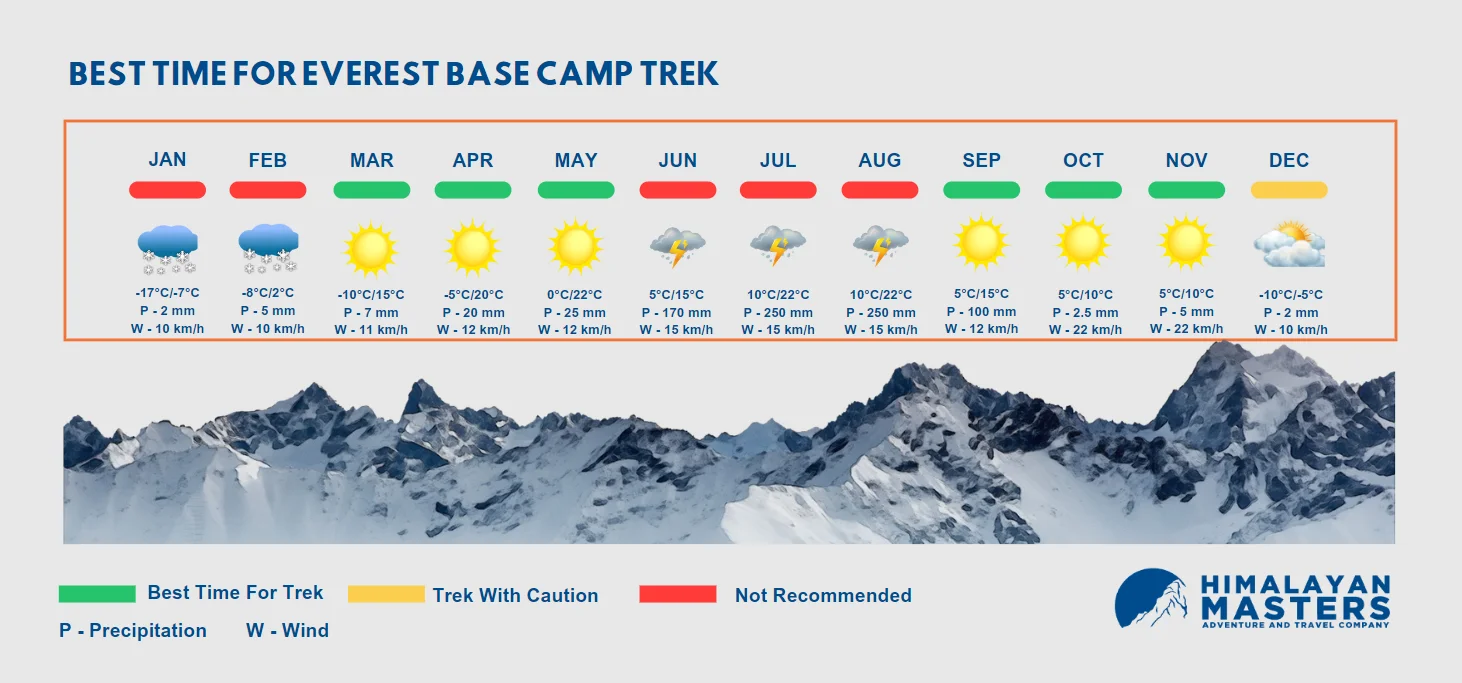
Temperature and Weather of Everest Base Camp
Everest Base Camp’s weather will be breezy and cold throughout the year. The summer in Everest lasts from April to September, with heavy rainfall in June and July.
In summer, the Everest temperature at Lukla can reach 18°C, but it drops below five °C in the Everest base camp. September and October have warm temperatures, low wind, and clear skies with no rainfall.
From November, all regions above 3000m start to receive heavy snowfall, with snow remaining until February.
In the winter, all areas above Lukla have negative temperatures of about -5 °C, while each can reach -15 °C in the Everest base camp. No rainfall or snowfall can also be seen between March and May.
Is Special Training Needed For EBC Trek?
No formal training is mandatory, but one should be physically fit and look for cardiovascular and weight training exercises. Yoga or any stretching exercise also enhances a person’s flexibility and balance.
What does a typical day on the EBC trek Look like?
The first and last days of the Everest trip will differ as you fly to and from Lukla. All nine other trekking days follow a standard format or schedule. Every day, we start the trek at around 8 a.m. Before that, prepare the bag and have breakfast in your tea house.
You should order breakfast in the evening to prepare the food when you wake up. Then, we start to hike for 3 to 4 hours. On the way, we will cross many forests, waterfalls, and rivers. Due to the clear sky, morning is the best time to capture pictures and videos.
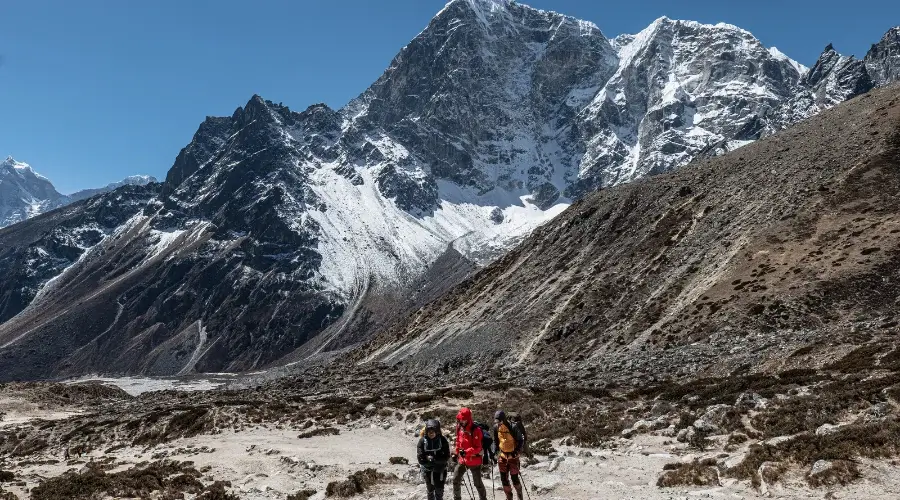
At around midday, the guide will find an appropriate stop for lunch. It will take us around one and a half hours to order and have lunch before we start the trek again. We will walk for another 3 to 4 hours and stop at many places. We visit many villages and monasteries along the way as we hike.
We reach the tea house at the given destination during the evening, i.e., around 4 to 5 o’clock. After that, you can have a quick tea break before you explore the village area. The dinner will be served from 7 to 10 p.m., and you can have any food from the menu provided to you. Sleeping at most minuscule o’clock is recommended so your body has enough time to rest.
Permits for Everest Base Camp
To begin the trek, trekkers must have a Khumbu Pasang Lhamu Rural Municipality Entrance Permit and a Sagarmatha National Park Entry Permit.
The Sagarmatha National Park Permit costs Rs. 3000 for foreigners, Rs. 1500 for SAARC countries, and Rs. 100 for Nepalis.
Khumbu Pasang Lhamu Rural Municipality Entrance Permit costs Rs. 2000 for the first four weeks, and if you stay longer than that, you will need to pay Rs.2500.
These Everest permits can be acquired in Kathmandu or from your trekking agent, though most trekkers prefer to have them from their agents.
Accommodation and Food on Everest Base Camp Trek
En route, lodges offer shelter to the trekkers through teahouses. Some facilities include basic sleeping accommodations in dormitory style and shared bathrooms among the occupants.
You can also find an attached bathroom, but not at higher altitudes. In Namche and Lukla, you can even find star-level teahouses/ hotels.
The meals are primarily Nepalese, with only a few international dishes. Trekkers should expect healthy meals and not hesitate to accommodate the local dishes. Western foods like dumplings, Pizza, pastry, and noodles are also available on the trek.
Electricity, Recharge & Water During the EBC Trek
Lighting, especially bulbs, is common but may be lacking or intermittent depending on the power availability within the premises. It will cost a few dollars to charge your phone and cameras. Also, you need to pay to use Wi-Fi.
Water can be bought from shops along the trail, but it must be purified to be safe for drinking or other uses, so a water purification system or tablets are advisable.
Roads on the Route and How to Avoid Them
The trekking route to Everest Base Camp has no major roads because it is situated on a well-trodden trail, except in some parts where it traverses small roads or could be jeep tracks if one is familiar with the trail. All trekkers should listen to what their guides or porters advise them about the areas since they know how to avoid the hazardous ones.
Alternative Trekking Routes for Everest Base Camp
Other trek trails in the region include the Gokyo Lakes and the Three Passes. These routes provide different outlooks and adventures but require more time and planning. It is advisable to discuss with your trekking agency to get the best route depending on one’s preferences, health status, and time available.
Everest Base Camp Trek Cost
The cost of the Everest Base Camp trek is $1500 per head. These are typical costs: air transfer, teahouse accommodation, meals during the trek, hiring a guide, porters, and necessary permits. Expenses not included in the base price include tipping, personal equipment, and other additional activities.
Insurance for EBC Trek
Trekking travellers should have all-inclusive travel insurance that embraces high-altitude trekking and evacuation services. This insurance must cover rescue by helicopter, medical bills, and any other costs that may occur in case of an accident.
Additional Expenses of Everest Base Camp Trek
Additional expenses on the Everest Base Camp trek may include tips for guides and porters, personal gear and equipment, and any extra activities or excursions. Trekkers should also budget for meals and accommodation in Kathmandu before and after the trek.
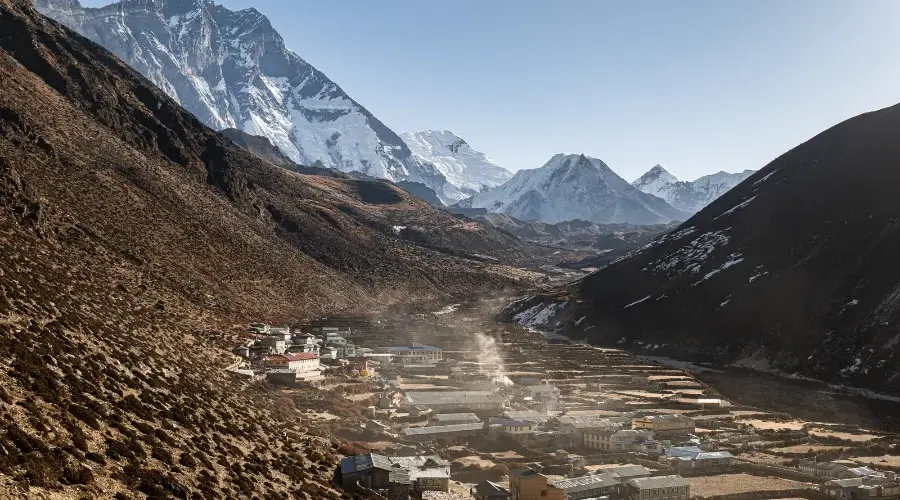
ATMs on Everest Base Camp Trek
ATMs are available in Kathmandu and some larger towns along the trek, like the Namche route, but may not always be reliable or accessible. You should bring sufficient cash in Nepalese rupees to cover expenses during the trek.
Why Himalayan Masters
First and foremost, we are legally registered with the Nepal government and the Trekkers Association of Nepal. We can quickly help you with the visa process and trekking permits.
All our guides are licensed and have many years of experience trekking at Everest Base Camp. We provide one guide for every 4–5 people and one porter for two trekkers. We have operated for almost a decade and worked with hundreds of satisfied trekkers worldwide.
The Himalayan masters always prioritize quality over quantity. This means we offer you the best accommodation in the region, and food is not restricted. If you are unsatisfied with the accommodation or food we provide, you can always request to change it. We also provide all essential trekking gear so that our tourists will not be worried about anything during the Trip.
Everest Base Camp Trek with Himalayan Masters
As with the Everest Base Camp trek, qualified guides and porters are always invaluable regarding tour safety and experience. This company has well-experienced guides and porters who know a lot about the people and the area. Thus, Himalayan Masters is a reputable trekking company that can offer guided trekking.
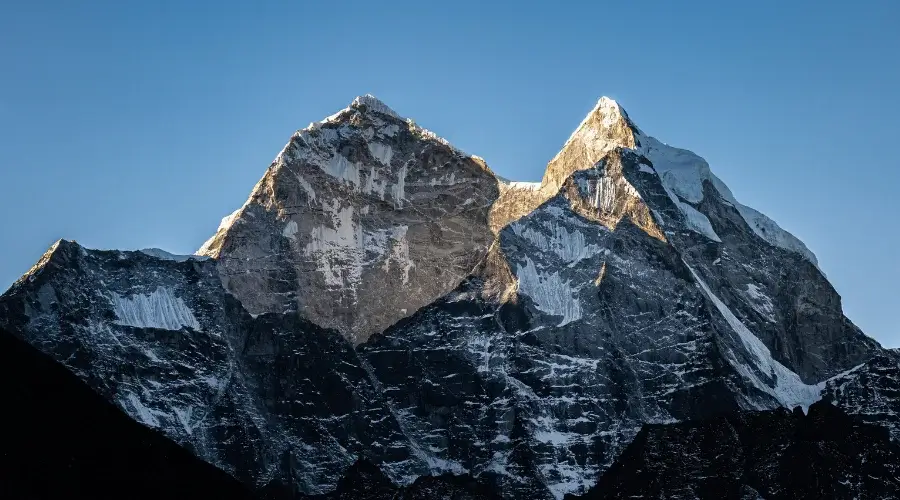
Booking/ Airport Pickup
Tourists can organize their EBC trek with, for instance, Himalayan Masters or other professional trekking companies. Many agencies are involved in airport pickup and drop-off services in the KTM, which means that tourists experience seamless arrival and departure.
Support Team
The personnel supporting the Everest Base Camp trek include the lead guide, guides, porters, and cooks. Trekkers have porters with support, sunglasses, and clothing to help them carry their belongings, and any other assistance may be offered.
Starting Point/ Ending Point
The most common and popular route to visit the EBC is through Lukla, a town in the Khumbu region of Nepal.
Communication in Everest Base Camp Trek
As Everest Base Camp is in a remote region, communication is also weak. In some areas, you can get connected via Nepal’s local SIM cards, NTC and Ncell. You will get Wi-Fi in some regions, but it is unreliable. So, one can purchase an Everest Link pack for better connection.
How do I contact the Himalayan Masters and book your EBC trek?
You can visit our website and check the itinerary cost and Everest base camp trek. After doing your research, you email us to provide your information regarding the schedule for the Everest EBC trek.
Then, we will provide you with an individualized Everest base camp trek itinerary. After you approve the EBC trek itinerary, you need to pay us 50% in advance so that we can start your booking procedure. Then you need to book your flight to Nepal; we are available at the Airport.
Cancellation policy:
If you decide to cancel the Everest EBC trek after you make the payment, we can refund the amount that has not gone into the booking. We cannot refund the ticket price if we have already purchased your aeroplane ticket to Lukla. Otherwise, we will refund up to 90% of your payment, depending on how long before the trip is cancelled.
Postpone policy:
No additional charges will be applicable if you postpone your Everest EBC trek. However, if we have already purchased your ticket from Kathmandu to Lukla, we cannot waive the ticket, and you might have to pay extra. Also, the money cannot be refunded if hotel bookings are made.
Tipping policy in Nepal:
Tipping in hotels and restaurants is uncommon in Nepal. You can move on without tipping tea houses or tipping off 10% of the food price if you like the hotel’s service at Everest Base Camp. Similarly, 10% tipping is also suggested for guides and porters to EBC. But if you appreciate their hard work, you can tip higher.
Can I extend the holiday or change the EBC trek route during my Trip?
Changing the route:
Once you arrive in Nepal, we can negotiate a change if you want to go on a trekking route different from Mt. Everest Base Camp. If no amount has been used to book or purchase the ticket, we will use all of your payment for new bookings on a different route.
Extension of EBC tour:
You can exchange your Kathmandu stay tour before and after the tour. You can have a few rest days in Kathmandu or visit other cities like Pokhara and Chitwan at the end of the trek. The Himalayan Masters arrange all adventurous activities like Bunjee, paragliding, and river rafting upon your request. Even on Everest, you can extend your trip to routes like three passes or Gokyo without issues.
Reviews
Himalayan Masters made my trip to Nepal phenomenal. From the start, I was a bit nervous about travelling alone as a 22-year-old female in Nepal especially on a two-week-long trek through the Himalayas. I reached out to Sandip a few weeks before my plans to arrive with my concerns and he made every effort to try to find someone who would be interested in my same dates when we did not find someone, he made me feel completely comfortable going alone and made sure my needs were met. Upon my arrival in Kathmandu, Sandip picked me up directly from the airport and took me to get gear. He was so sweet and even lent me some of his gear (his beautiful summit suit and other items) since he had just gotten back from a trip himself. He even offered me his own trekking boots to borrow for my trek but they were a tad too big. He was so generous and helpful with the preparation of my trip and truly made me feel like I was valued as a customer, I could not be more grateful, especially being a solo female backpacker, I was used to very different treatment. When my trip started, we had a one-day delay from a storm, and because Sandip knew of my tight date restrictions, he made sure that I was put on the first helicopter the next morning to start my trek. My guide was Pradip, who was equally fantastic. He was really fun to talk to all day and always included me when meeting with the other guides. He was very attentive and super kind, I felt very comfortable the entire trip and had so much fun. I was impressed by the accommodations, with my EBC package purchased, I always was able to get whatever meals I wanted and I could see both Sandip and Pradip were always working to be sure I had a comfortable or private room if available. At one point in the trip, I was debating extending to Gokyo Lakes in addition to EBC, Sandip was incredibly helpful with calling places for me to see if this was possible with my date restrictions. I, however, decided to not extend because I was feeling ill from altitude sickness, which Pradip was so helpful with and supported me through reaching Everest Base Camp. Pradip was especially helpful when on day 13 of 15, I became incredibly sick when we reached Namche Bazaar for the second time on the way down. I could not stop throwing up, getting sick, and passing out. I believe that this was a mix of altitude sickness and food sickness. Sandip was incredibly helpful when helping me with this, he was in contact with my father who was back in the US giving him updates on my condition and he organized a helicopter to get me from Namche and take me to Kathmandu to the hospital. Sandip met me at the airport there in an ambulance took me to the hospital and made sure that I was well taken care of. I had to stay four days in the Kathmandu hospital before flying home, and Sandip came every day to check on me and to be sure that I was getting everything I needed. He even drove me back to his office and got me a hotel room so that I could nap for a few hours before my flight after my hospital discharge. He then drove me to the airport and left me with very kind words. I cannot recommend Himalayan Masters enough, they are a phenomenal company that obviously truly cares about their patrons. Sandip is a wonderful human and I would trust him to make the best trip for anybody!
Monica KUSA 🇺🇸
I did the EBC + Gokyo trek with Himalayan Masters in May 2024. My tour booking took place through Sandip (the owner), my guide was Himesh, and my porter was Ravi.
I could not possibly recommend Himalayan Masters more. After having done a 16-day tour with them, I can see why their reviews are so consistently excellent.
Here are five main reasons to choose Himalayan Masters:
1. Integrity and honesty—if, like me, you are travelling to a new country for a non-inexpensive tour and perhaps even doing it solo, the #1 concern on your mind is whether you are dealing with a legitimate and honest party. You are in this case. At every turn, they have acted in my best interests, even when it was probably at an additional cost to them
2. Client-centricity: these guys are very passionate about their work. Every little detail of the trip was executed in a way that would optimise my experience. From the airport pick-up to the hiking experience, etc. For example, Sandip insisted on arranging my drop off at KTM airport even though I stayed in Kathmandu for several days beyond the trek. Another example – when there was something minor I didn’t like about one of my tea house rooms, Himesh immediately got me moved to another room that he felt would suit me better—without any question
3. Cost: Sandip and Himesh did not cut any corners with costs. They put me up in the best teahouses along the trek. They arranged for me to fly from Kathmandu to Lukla by helicopter instead of driving four hours to Ramechap for a flight to Lukla, which was what other hikers had to do at the time. This helicopter ride wasn’t part of my package and probably came at an additional cost to them, but at no extra cost to me. They also gave/lent me a lot of necessary gear for free: – a t-shirt, cap, down jacket, trekking poles, water bottle, water purification tablets, crampons, sleeping bag, etc. All of these make their already competitive pricing even more worth it
4. Skill and experience—their guides and porters are very good at what they do and will look after you well. They will be your best friends on the trek. Himesh was an absolute legend; the hike wouldn’t have been the same without him. He looked after me very well and made the entire trip more enjoyable thanks to his deep knowledge and engaging personality
5. Miscellaneous benefits of having a well-connected tour operator—for example, getting me onto a helicopter/plane when other hikers were unable to get onto one themselves!It was a fantastic experience with Himalayan Masters, and I’ll be referring family and friends to them for future Nepal trips. I should add that at the start of my hike. I encountered a couple of trekkers who had just finished their tour with Himalayan masters and gave me the same feedback as above.
Arjun Msingapore 🇸🇬
FAQs
How long is Everest Base Camp Trek?
Usually, Everest Base Camp Trek can be completed within 10-12 days, with 2 resting/acclimatizing days. However, depending on your trekking capacity or preference, it can be completed in fewer or more days. Also, you can take a helicopter return from EBC to shorten your trekking days.
How frequent is altitude sickness on the Everest base camp trek?
Is Everest Base Camp trek for Solo travelers (especially females)?
Is the Everest Base Camp trek with family (old parents and children possible)?
Do I need any training before the Everest Base Camp trek?
What happens if I get altitude sickness during the Everest trek?
Can an average person with less stamina do the Everest Base Camp trek?
Do I need travel insurance for the EBC trek?
How hard is Everest Base Camp trek?
Do I need extra oxygen for the EBC trek?
How to protect yourself from the sun during the Everest EBC hiking?
What is the hotel in Everest like?
Can I get a private room at a hotel in Everest?
What is the condition of the washroom like?
What kind of food I can get during the hiking to Everest base camp?
Is vegetarian food available in EBC hiking?
Do I get drinking water in EBC base camp?
Is there a laundry system in Everest?
How to charge my phone?
Is there internet in the Everest base camp?
How much extra money should I carry for the hike to Everest Base Camp trek cost?
What is the per-day expense during the EBC trek cost?
Can I use a card instead of cash in Nepal?
Can I withdraw cash from the ATM during the Everest Base camp trek?
When and how to pay for a guide and porter on EBC hike?
What documents do I need for EBC hike?
What is the post-Covid-19 impact on Everest?
Do I need a TIMS card for the trek to Everest base camp?
Speak to an Expert





Sandip Dhungana
Nepal 🇳🇵
Whatsapp: +977-9823636377
Speak to an Expert





Sandip Dhungana
Nepal 🇳🇵
Whatsapp: +977-9823636377



